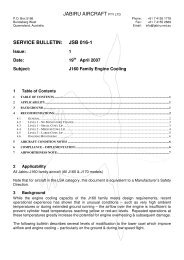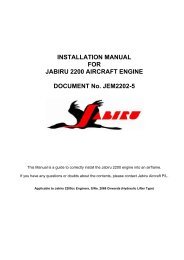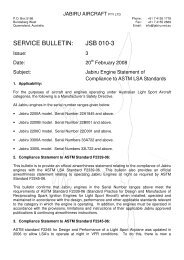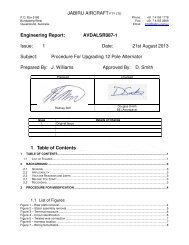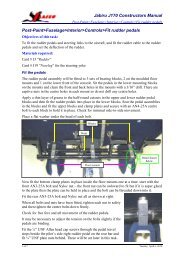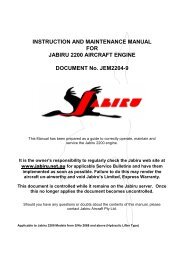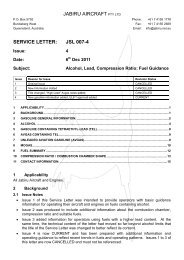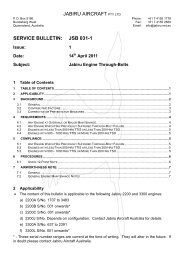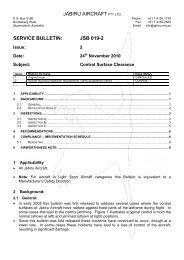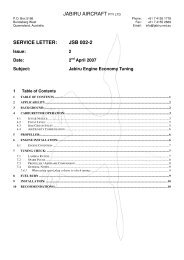Propeller Technical Manual - Jabiru
Propeller Technical Manual - Jabiru
Propeller Technical Manual - Jabiru
You also want an ePaper? Increase the reach of your titles
YUMPU automatically turns print PDFs into web optimized ePapers that Google loves.
<strong>Propeller</strong> <strong>Technical</strong> <strong>Manual</strong><br />
JPM0001-1<br />
<strong>Jabiru</strong> Aircraft Pty Ltd<br />
4A482U0D And 4A484E0D <strong>Propeller</strong>s<br />
5.6 Repair Methods<br />
5.6.1 <strong>Propeller</strong> Balancing Procedure (Overhaul)<br />
Both propellers are balanced during manufacture using a method able to detect very small imbalances<br />
between blades.<br />
If an imbalance is detected in the propeller assembly during overhaul it is recommended that BOTH<br />
blades be returned to the manufacturer for re-balancing.<br />
The following procedure is given as a basic check of balance which may be done in the field however<br />
accuracy of this process is not as high as using the factory balancer.<br />
<strong>Propeller</strong> balance jigs must meet the requirements of Section 5.3.1.<br />
Check the balance jig to ensure that the “knife edges” are straight and level.<br />
Ensure the propeller is clean and dry: if necessary, clean the blades to ensure all deposits are removed<br />
then dry thoroughly.<br />
Fit the propeller to the balance shaft.<br />
Place the propeller on the rig, with the balance shaft resting on the knife edges. Initially test with the<br />
propeller blades horizontal: the heavier blade will sink to the bottom.<br />
Repeat the test with the propeller blades vertical: the heavier side of the propeller will sink towards the<br />
bottom.<br />
Ensure the balancing is being done in a closed room – drafts or gusts of wind will rotate the propeller and<br />
give inconsistent balancing.<br />
The balance may only be corrected by the application of enamel paint. Any other method of securing<br />
balance is PROHIBITED.<br />
Do not apply paint over the Urethane leading edge – it will rapidly flake off in service which is both<br />
unsightly and will affect the balance of the propeller.<br />
<strong>Propeller</strong>s outside these limits should be rejected as unserviceable or returned to JABIRU for assessment<br />
and possible repair.<br />
Tolerances:<br />
Imbalance shall not exceed the following limit whatever the position of the <strong>Propeller</strong> in the plane of<br />
rotation: 750 mm-gms (approximately 1 gm at the tip).<br />
5.6.2 Damage Limits & Repairs<br />
Any service or repair must take account of the risk of subsequent <strong>Propeller</strong> failure. Therefore repairs by<br />
owners are limited to minor damage. Larger damage must be referred to <strong>Jabiru</strong> Aircraft for repair.<br />
Only damage within the size tolerances described in Section 4.8.1 may be repaired by owners. All propellers<br />
with damage beyond these limits must be either rejected as unserviceable or returned to JABIRU Aircraft Pty<br />
Ltd or our local approved agent for assessment and possible repair.<br />
5.6.3 General<br />
Repairs must always take account of the changes to balance of the <strong>Propeller</strong>. Generally for repairs the<br />
propeller should be removed in accordance with the procedure described above (Section 4.7.2) and checked<br />
for balance (Section 5.6.1) prior to refitting (Section 4.7.3). Always check blade & spinner tracking after<br />
reassembly (Section 4.7.3).<br />
This document is controlled while it remains on the <strong>Jabiru</strong> server. Once this no longer applies the document becomes uncontrolled.<br />
ISSUE 1 Dated : 1st Feb 2013 Issued By: DPS Page: 31 of 32<br />
L:\files\<strong>Manual</strong>s_For_Products\<strong>Propeller</strong>_<strong>Manual</strong>s\JPM0001-1_Prop_<strong>Manual</strong> (1).doc





